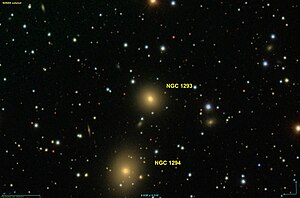NGC 1293
| Galaxy NGC 1293 |
|
|---|---|

|
|
| SDSS recording | |
| AladinLite | |
| Constellation | Perseus |
|
Position equinox : J2000.0 , epoch : J2000.0 |
|
| Right ascension | 03 h 21 m 36.4 s |
| declination | + 41 ° 23 ′ 34 ″ |
| Appearance | |
| Morphological type | E0 |
| Brightness (visual) | 13.5 likes |
| Brightness (B-band) | 14.5 mag |
| Angular expansion | 0.9 ′ × 0.9 ′ |
| Surface brightness | 13.3 mag / arcmin² |
| Physical data | |
| Affiliation | Perseushaufen NGC 1272 -Group WBL 97 LGG 91 |
| Redshift | 0.013920 ± 0.000019 |
| Radial velocity | 4173 ± 6 km / s |
|
Stroke distance v rad / H 0 |
(191 ± 13) · 10 6 ly (58.5 ± 4.1) Mpc |
| history | |
| discovery | William Herschel |
| Discovery date | October 17, 1786 |
| Catalog names | |
| NGC 1293 • PGC 12597 • CGCG 540-116 • MCG + 07-07-075 • 2MASX J03213647 + 4123340 • GC 686 • H III 574 • h 294 • GALEX ASC J032136.41 + 412333.6 • LDCE 224 NED224 | |
NGC 1293 is an elliptical galaxy from the Hubble type E0 in the constellation Perseus the northern sky . It is estimated to be 191 million light years from the Milky Way and has a disk diameter of about 50,000 light years. It forms an optical galaxy pair with NGC 1294 and is a member of the Perseus Cluster .
In the same area of the sky are u. a. the galaxies NGC 1279 , NGC 1281 , NGC 1282 , NGC 1283 .
The object was discovered on October 17, 1786 by the astronomer Wilhelm Herschel .
Web links
Commons : NGC 1293 - collection of images, videos, and audio files
